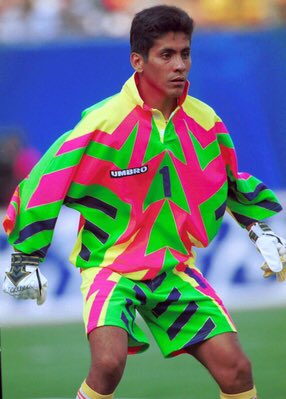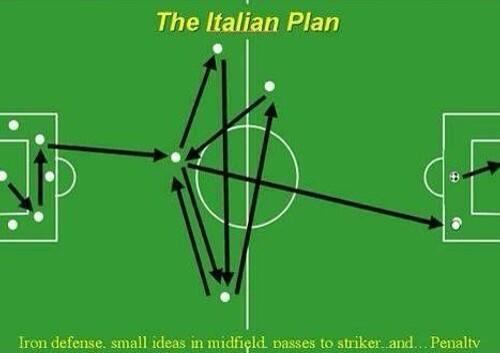The joys of recreational soccer are countless. Whether it’s the ability to continue to play the sport you love long after your competitive career is over, an opportunity to stay in shape without the tedium of the gym or a chance to get together and tear into your friend who supports Manchester United, rec-league soccer can be the highlight of the week. It’s a chance to forget about the travails of work and the pressures of everyday life.
Unless, of course, your team has become a microcosm of life’s suffering. In that case, getting out of bed early on the weekends to partake in the ritual of getting your ass kicked can begin to frustrate rather quickly. Luckily, there are some precautions you can take to ensure that this spring doesn't turn into your season in hell.
The difference between winning the lowest division of your recreational league and finishing without a win is established in the finest of margins. Follow these five proven steps and you’ll be on your way to a successful and joyful league season.
5 Proven Steps in Creating a Dominant Soccer Team
Step 1: Recruit a Goalkeeper

A goalkeeper likes living life on the edge. Photo: @JBury94 | Twitter
The first and foremost action you’ll need to take with regards to forming the ultimate recreational soccer team is to pin down a goalie. Without a keeper, you’ll be forced to constantly bicker over whose turn it is. This is where friends become enemies and once promising teams quickly become a laughing-stock.
This will also lead to some teammate falsehoods regarding acute wrist pain and traumatic childhood experiences which will invariably lead to you being the only option in goal. This is the worst thing that can possibly happen to you over the course of the season. Make a couple saves and you won't see the field until fall. I've seen people kill for less.
Ideally, you’ll have a player who’s so consistently tired that they’ll claim the goalie position. Perhaps they were once a defender but that glorious heyday has come and gone. Now, their place is between the sticks. Sure, they may not know the finer points of keeping and will be accountable for 1-2 calamitous goals a game, but that’s certainly a better option than the alternative.
If this kind of player isn’t available, your next best bet is to just survey the fields over the course of a few hours. There’ll inevitably be a keeper that pops up over and over again. This particular individual plays five days a week for seven different teams and may just be able to squeeze one more in. The only downside is that they’ll have a tough choice to make when two of their teams face off directly against one another.
Additional points for finding a goalie who can take their own goal kicks, the directness of which will lead to roughly 60-70 percent of your team’s goals this season.
Step 2: Get a Classic Hard-Man/Woman

Calm down, George. Photo: @chiellindonesia | Twitter
It’s a rough and tumble world out there in the rec-leagues. The conditions of the pitch bear more resemblance to the surface features of Mars than the pristine carpets of grass you see on NBC. Referees are hesitant to make calls, allowing the game to proceed in its most primal form.
Whether that’s from a basic lack of knowledge of the rules, apathy at having to spend their Sunday mornings watching this clusterf***, or just a general aversion towards your face that grants them pleasure from seeing you kicked, you’re not going to be afforded much protection.
Enter the hatchet man/woman. This player's favorite parts of the game are bench clearing brawls and hospital balls. Their tackles are generally always late, their best move is a cheeky stamp on an opponent's foot and they’ll always get in an embarrassing shouting match with the opponent's resident psychopath before the match is over, much to the chagrin of all the other players and spectators.
Lucky to finish the season without a lifetime ban from the premises, this violent character will make sure the other team is too appalled and horrified to even try.
Step 3: Find an 18-year-old Teetotaler Wonderkid
Sir Alex Ferguson knew what he was talking about. One of the first things he changed as manager of Manchester United was the club's stance towards alcohol and smoking, vices which had been prevalent at the club for years. “The relationship with alcohol is a real problem in English football and, in the short term, it’s much more harmful to a sportsman. It weakens the body, which becomes more susceptible to injury,” said Ferguson.
Anyone who has been smoking and drinking for a number of years can vouch for that. However, Ferguson is fond of a good red wine himself. After all, he wasn’t the one who needed to log the miles on the pitch. Football is a young man’s game, so go and find yourself a young fitness phenom who can run circles around the rambling beer bellies that comprise your league.
Last night they studied and went to bed early. Last night you stayed out until bar close. They frequent the gym and can still manage to touch their toes. You frequent Chipotle and haven’t stretched since high school. While everyone else is twanging their hamstrings and wondering what’s for lunch, this indomitable lion cub will single handedly marshall your defense, midfield and attack.
Step 4: Decide on a Formation and Philosophy

We're playing with one in the hole, you say? Photo: @SoccerFouls | Twitter
Chances are, your team contains multiple player-coaches and defensive/midfield organizers. These individuals have watched their fair share of elite European football and know that the 4-2-3-1 formation is all the vogue. They want to press, they want to possess and they want Xabi Alonso and Thomas Muller to materialize out of thin air to operate as your regista and false-9.
If you don’t decide on a formation and style of play early, halftime discussions will routinely involve the sum total of every action and configuration that the sport allows.
“We just need to focus on the final pass.”
“We need to shoot more.”
“We need to play the ball wide.”
“Let’s concentrate on winning the battle in the middle.”
“Everyone needs to get back on defense.”
“Everyone needs to join the attack.”
These seemingly conflicting ideas will be rattled out verbatim, the ultimate result being a team that retakes the field attempting to consolidate the clashing philosophies of Barcelona and Stoke City. It’s a difficult task for a group of players that haven’t played for weeks, spent the warmups attempting to flat tire each other’s shoes and whose pregame meal consisted of chicken curry and a cold one.
You’ll want to play a 4-4-2. You’ll want to substitute a lot. Other than that, a hit and hope strategy is always a good, albeit less hipster, philosophy.
Step 5: Limit the Appearances of Ringers (or don’t!)

What'd you say your name was again? Photo: @london_soccer | Twitter
It happens: there’ll be one week that amounts to the perfect storm of player absences. A couple players are sick, one’s injured, one needs to work and anothers parents are in town. To hell with playing without substitutes, you need to get someone in.
The downside of it all is the pandora’s box of evil that this might open. They haven't paid, their shirt color is bewilderingly close to the oppositions and their not here to take a breather. No substitutions, no communication and no signs of skill later, they say they had such a good time that they’ll be back next week. Uninvited of course. God dammit!
There’s also the off chance that this will work out for the best. Hell, you might even win this week thanks to this newfound twinkle toes. They’re playing in a league much beneath their skill level and they actually seem pretty nice! Get their phone number, save it in your phone as “El Niño the Maestro” and prepare to climb the league table.
So, best of luck this spring. Remember the 5 proven steps in creating a dominant soccer team and you'll do just fine.






